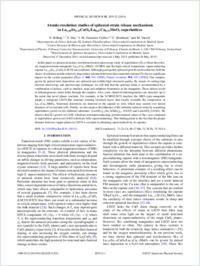Atomic-resolution studies of epitaxial strain release mechanisms in $\mathrm{L}{\mathrm{a}}_{1.85}\mathrm{S}{\mathrm{r}}_{0.15}\mathrm{Cu}{\mathrm{O}}_{4}/\mathrm{L}{\mathrm{a}}_{0.67}\mathrm{C}{\mathrm{a}}_{0.33}\mathrm{Mn}{\mathrm{O}}_{3}$ superlattices
- Biškup, N. Departamento de Física Aplicada III, Instituto Pluridisciplinar, Universidad Complutense de Madrid, Spain - Centro Nacional de Microscopía Electrónica, Universidad Complutense de Madrid, Spain
- Das, Saikat Department of Physics, Fribourg Center for Nanomaterials, University of Fribourg, Switzerland
- Gonzalez-Calbet, J. M. Centro Nacional de Microscopía Electrónica, Universidad Complutense de Madrid, Spain - Departamento de Química Inorgánica, Universidad Complutense de Madrid, Spain
- Bernhard, Christian Department of Physics, Fribourg Center for Nanomaterials, University of Fribourg, Switzerland
- Varela, M. Departamento de Física Aplicada III, Instituto Pluridisciplinar, Universidad Complutense de Madrid, Spain
-
26.05.2015
Published in:
- Physical Review B. - 2015, vol. 91, no. 20, p. 205132
English
In this paper we present an atomic-resolution electron microscopy study of superlattices (SLs) where the colossal magnetoresistant manganite La0.67Ca0.33MnO3 (LCMO) and the high critical temperature superconducting cuprate La1.85Sr0.15CuO4 (LSCO) are combined. Although good quality epitaxial growth can be achieved, both the choice of substrate and the relatively large lattice mismatch between these materials (around 2%) have a significant impact on the system properties [Phys. C 468, 991 (2008); Nature (London) 394, 453 (1998)]. Our samples, grown by pulsed laser deposition, are epitaxial and exhibit high structural quality. By means of cutting-edge electron microscopy and spectroscopy techniques we still find that the epitaxial strain is accommodated by a combination of defects, such as interface steps and antiphase boundaries in the manganite. These defects result in inhomogeneous strain fields through the samples. Also, some chemical inhomogeneities are detected, up to the point that novel phases nucleate. For example, at the LCMO/LSCO interface the ABO3-type manganite adopts a tetragonal LSCO-like structure forming localized layers that locally resemble the composition of La2/3Ca4/3MnO4. Structural distortions are detected in the cuprate as well, which may extend over lateral distances of several unit cells. Finally, we also analyze the influence of the substrate-induced strain by examining superlattices grown on two different substrates: (LaAlO3)0.3(Sr2AlTaO6)0.7 (LSAT) and LaSrAlO4 (LSAO). We observe that SLs grown on LSAT, which are nonsuperconducting, present reduced values of the c axis compared to superlattices grown on LSAO (which are fully superconducting). This finding points to the fact that the proper distance between copper planes in LSCO is essential in obtaining superconductivity in cuprates.
- Faculty
- Faculté des sciences et de médecine
- Department
- Département de Physique
- Language
-
- English
- Classification
- Physics
- License
- License undefined
- Identifiers
-
- RERO DOC 257329
- DOI 10.1103/PhysRevB.91.205132
- Persistent URL
- https://folia.unifr.ch/unifr/documents/304605
Statistics
Document views: 77
File downloads:
- ber_ars.pdf: 130
